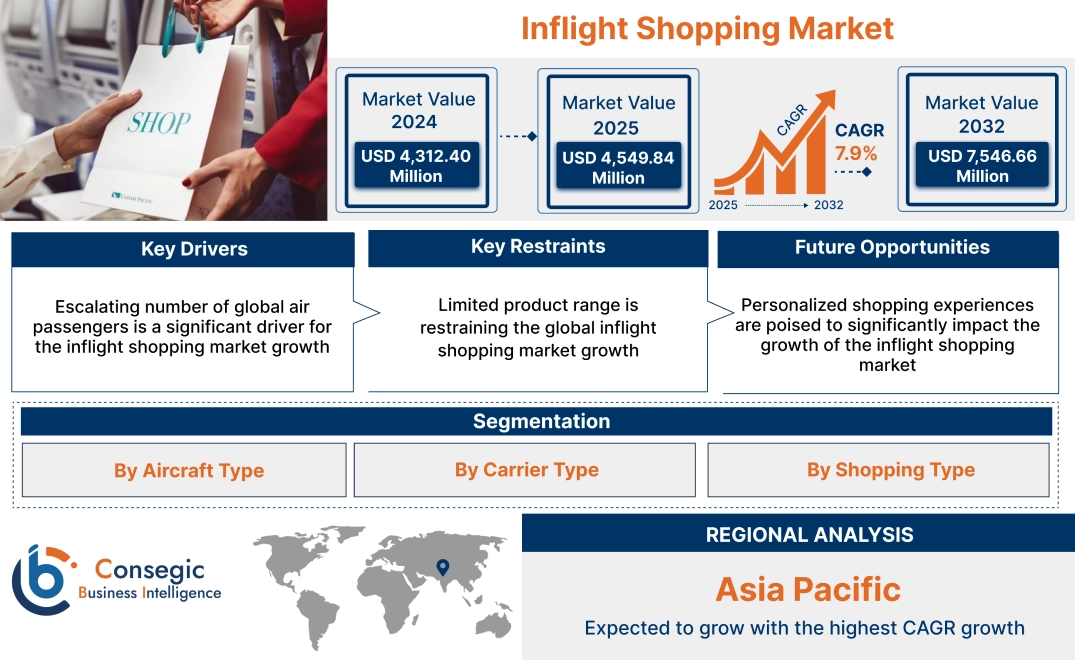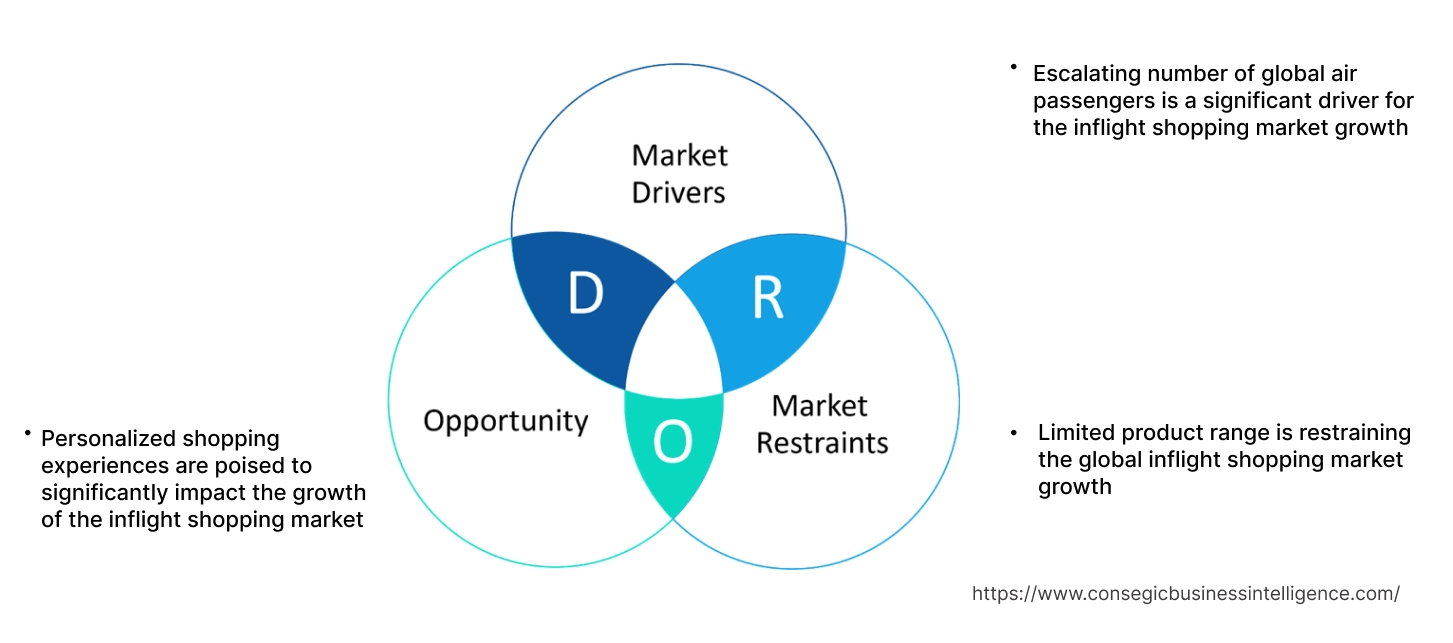- Summary
- Table Of Content
- Methodology
Inflight Shopping Market Size:
Inflight Shopping Market Size is estimated to reach over USD 7,546.66 Million by 2032 from a value of USD 4,312.40 Million in 2024 and is projected to grow by USD 4,549.84 Million in 2025, growing at a CAGR of 7.9% from 2025 to 2032.
Inflight Shopping Market Scope & Overview:
Inflight shopping is a retail service offered to passengers on airplanes, where they purchase a variety of goods, typically luxury items, duty-free products, and travel-related merchandise. These sales are often facilitated through catalog-based or digital shopping platforms provided by the airline.
Key Drivers:
Escalating number of global air passengers is a significant driver for the inflight shopping market growth
The surge in air travel translates to a substantial increase in potential customers within a confined space, creating a captive audience ripe for retail engagement. Airlines are capitalizing on this by enhancing the shopping experience through digital catalogs, pre-ordering options, and personalized recommendations, making the process more convenient and engaging for passengers. Moreover, the appeal of duty-free prices on a wide array of products, from luxury goods and electronics to local souvenirs and travel essentials, further incentivizes passengers to partake in shopping.
- For instance, according to IATA, the global air travel industry witnessed robust rise in August 2024, with total passenger demand (RPK) surging 8.6% year-over-year, outpacing capacity growth (ASK) at 6.5%. This strong demand resulted in a record-high passenger load factor of 86.2%, indicating high aircraft utilization. Domestic traffic saw a 5.6% increase, led by significant increase in China and Japan. International passenger traffic experienced even stronger expansion at 10.6%, with Asia Pacific and Latin America leading the way with double-digit increases.
- Thus, as per the analysis, increased air travel, captive audience, improved shopping experience, and attractive pricing is driving the inflight shopping market share.
Key Restraints:
Limited product range is restraining the global inflight shopping market growth
By offering a narrow selection, businesses fail to address the diverse needs and preferences of their target audience, potentially leading to lost sales and diminished customer satisfaction. This limitation also hinders competitive advantage, as rivals with broader offerings capture a larger market by catering to a wider spectrum of consumer needs. Furthermore, a restricted product line restrains growth opportunity, limiting the company's ability to diversify into new market segments.
Thus, as per the inflight shopping market analysis, limited product range is impeding the inflight shopping market growth.
Future Opportunities :
Personalized shopping experiences are poised to significantly impact the growth of the inflight shopping market
By leveraging data analytics and AI, airlines are expected to curate personalized product recommendations based on individual passenger preferences, travel history, and browsing behavior. This targeted approach is expected to increase customer engagement with shopping catalogs and a higher propensity to purchase. Additionally showcasing products that are relevant to individual passengers' interests, airlines are predicted to improve the chances of a successful sale, leading to higher conversion rates and increased revenue for inflight retailers. Furthermore, airlines that offer personalized shopping experiences are expected to differentiate themselves from competitors by providing a unique and valuable service to their passengers. This can attract price-insensitive customers who are willing to pay a premium for a superior shopping experience.
- Hence, based on the analysis personalized shopping experiences presents significant inflight shopping market opportunities.
Inflight Shopping Market Segmental Analysis :
By Aircraft Class:
Based on aircraft class, the market is categorized into first class, business class, premium economy class, and economy class.
Trends in the Aircraft Class:
- Beyond products, first-class shopping emphasizes unique experiences, such as exclusive access to airport lounges, luxury travel packages, or collaborations with renowned brands.
- Business class passengers seek a balance between value and luxury. Airlines offer a mix of premium and affordable products, focusing on convenience and efficiency.
The first class segment accounted for the largest revenue share of 47.09% in 2024
- Airlines curate exclusive and high-end product selections specifically for first-class passengers, featuring luxury brands and limited-edition items.
- First-class passengers receive personalized attention from flight attendants, including tailored shopping recommendations and assistance.
- In addition to products, first-class inflight shopping emphasizes unique experiences, such as exclusive access to airport lounges or collaborations with renowned brands.
- Thus, as per the analysis, the aforementioned factors are driving the inflight shopping market size.
The premium economy class segment is expected to register the highest CAGR over the forecast period
- The global rise of the middle class is predicted to create a larger pool of travelers seeking a more comfortable and enjoyable travel experience without the significant expense of business class.
- Airlines are offering exclusive discounts and promotions to premium economy passengers, further incentivizing purchases and driving the inflight shopping market trend.
- Also, the increasing initiatives by airways in upgrading the premium economy is also boosting the market size.
- For instance, Thai Airways launched a new Premium Economy class on their Airbus A330-300 aircraft. This development is part of a growing trend among airlines to enhance their inflight shopping experiences, particularly in the Premium Economy cabin. The new premium economy seats on the A330-300 offer increased legroom, personal armrests, and larger entertainment screens. These features provide a more comfortable and enjoyable travel experience for passengers, making them more receptive to inflight shopping market opportunities.
- Therefore, as per analysis, the aforementioned premium economy inflight shopping market trends are expected to continue to drive expansion in the coming years.
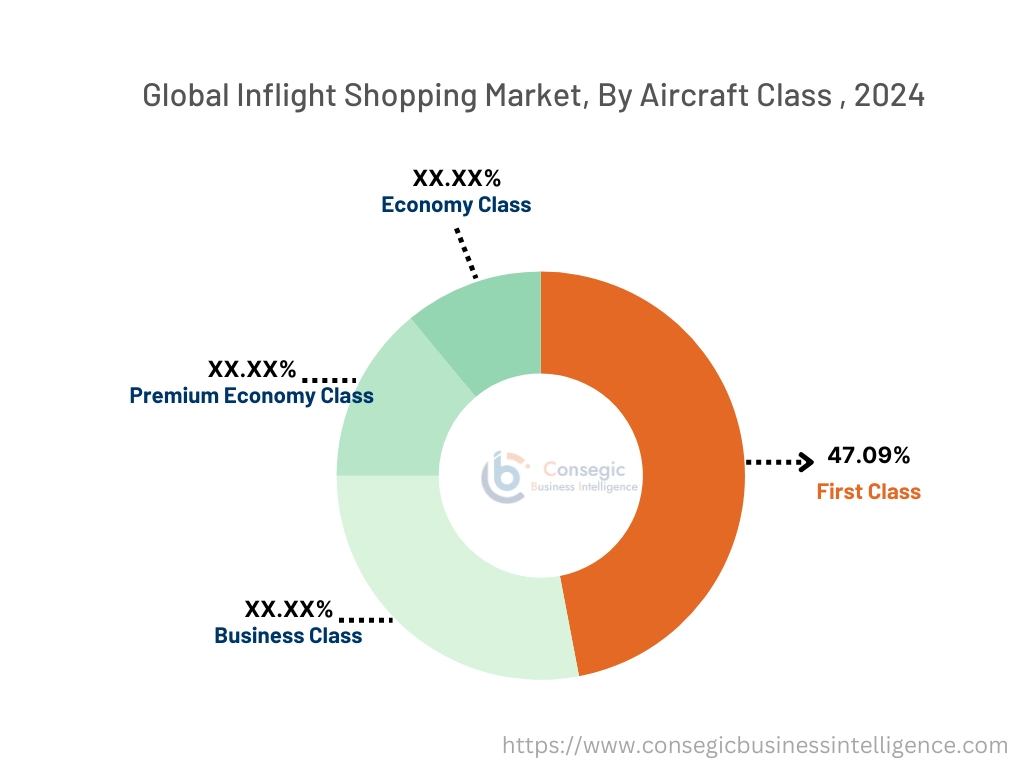
By Carrier Type:
Based on the carrier type, the market is segmented into full-service and low-cost.
Trends in the Carrier Type:
- Full-Service carriers offer a wider range of high-end and luxury products, often featuring exclusive brands and limited-edition items.
- Low-Cost carriers emphasize value and competitive pricing, with exclusive discounts and promotions.
The Full-Service segment accounted for the largest revenue share in 2024
- They offer a wider range of high-end and luxury products, often featuring exclusive brands and limited-edition items.
- Established full-service carriers have stronger brand equity, allowing them to leverage their brand image to offer exclusive merchandise and collaborations.
- Full-service carriers generally prioritize customer experience, which includes personalized service, curated shopping experiences, and a wider range of amenities.
- For instance, Emirates launched EmiratesRED, an enhanced inflight shopping experience that goes beyond duty-free. Customers can browse and purchase a wide range of products, including exclusive experiences in Dubai and beyond, and items from the Emirates Official Store. Additionally, to showcase this, Emirates introduced EmiratesRED TV, a dedicated shopping channel on their ice entertainment system. The revamped EmiratesRED catalogue boasts over 150 products from top brands, including exclusive items like scents from Boadicea the Victorious and skincare from Sea Buck Switzerland, making it a competitive shopping destination even compared to luxury department stores.
The low-cost segment is expected to register the highest CAGR over the forecast period
- Low-cost carriers are adept at offering attractive prices and convenient shopping options including competitive pricing, frequent promotions, and convenient payment methods.
- Low-cost carriers are embracing digital technologies to enhance the shopping experience including online catalogs, mobile payment options, and personalized recommendations.
- Low-cost carriers are forming strategic partnerships with retailers and brands to offer exclusive products and promotions, enhancing the appeal of their shopping programs.
- For instance, in January 2024, gateretail partnered with Wizz Air to enhance the airlines inflight shopping experience. The collaboration focuses on expanding the product range available to passengers, offering affordable and appealing products across different categories including cosmetics, snacks, electronics and travel essentials.
- Consequently, these factors are predicted to contribute to the low-cost inflight shopping market expansion.
By Shopping Type:
Based on the shopping type, the market is segmented into travel essentials, accessories, beauty and care, children, and others.
Trends in the Shopping Type:
- Increasing demand of noise-canceling headphones, travel pillows and blankets, and eye masks and earplugs to enhance comfort and relaxation during flight.
- Airlines are increasingly partnering with luxury beauty brands to offer exclusive products and collections.
Travel Essentials accounted for the largest revenue share of XX% in the year 2024 and is projected to witness fastest CAGR
- Growing adoption of noise-canceling headphones with personalized settings, better sound quality, and more comfortable ear cups.
- Travel pillows with improved ergonomic designs, memory foam, and adjustable features are driving the inflight shopping market demand.
- Moreover, increasing use of eye masks with cooling gels, aromatherapy, and Bluetooth integration for enhanced relaxation is also raising the inflight shopping market size.
- Furthermore, increasing demand for high-capacity, fast-charging portable chargers and power banks to keep devices powered throughout the journey.
- Therefore, the aforementioned factors are contributing significantly in accelerating the inflight shopping market share.
Regional Analysis:
The global Inflight Shopping market has been classified by region into North America, Europe, Asia-Pacific, MEA, and Latin America.
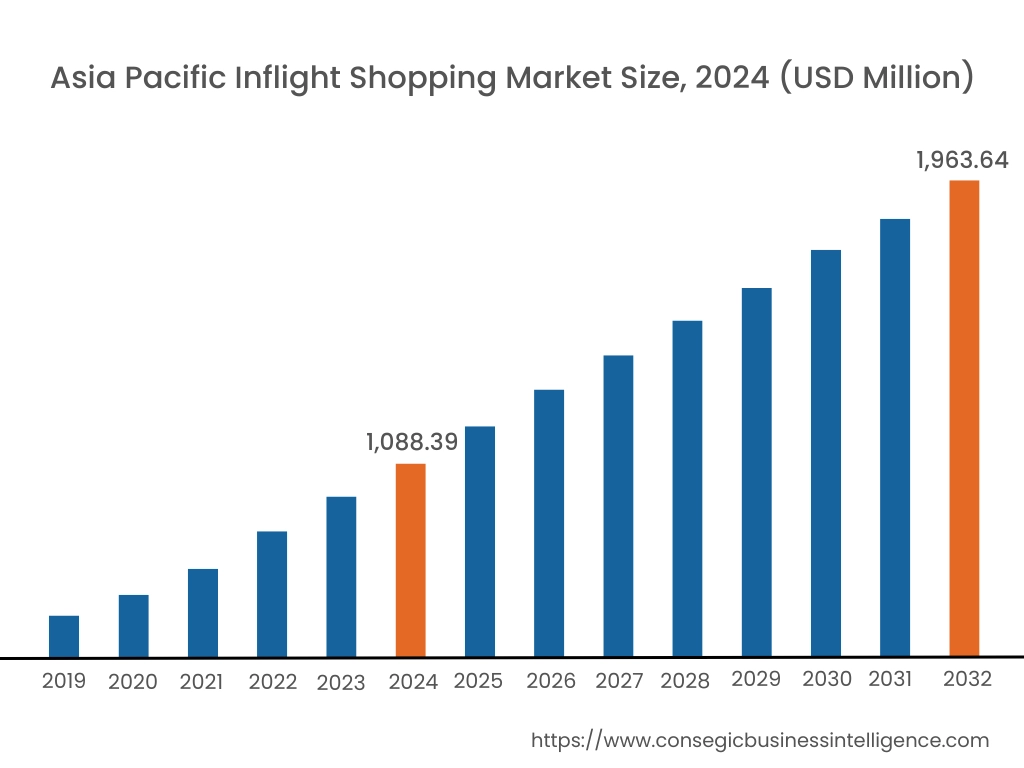
Asia Pacific region was valued at USD 1,088.39 Million in 2024. Moreover, it is projected to grow by USD 1,151.28 Million in 2025 and reach over USD 1,963.64 Million by 2032. Out of these, China accounted for the largest revenue share of 27.3% in 2024.
The Asia-Pacific region is predicted to register substantial rise due to a combination of factors including the high volume of air travel, rising disposable incomes, and a growing middle class in countries like China, India, and Japan. The region is home to some of the world's busiest airports and airlines, leading to increased inflight shopping market demand. Additionally, the growing trend of luxury and branded goods, along with the increasing preference for convenience shopping during flights, further drives the popularity in this region. Also, the presence of key players in the industry creates potential inflight shopping market opportunities.
- For instance, in December 2024, Santan significantly enhanced its inflight retail solution, Fasspos, in partnership with Soft Space, a global leader in fintech-as-a-service. This upgrade aims to transform the inflight dining and shopping experience for passengers. By leveraging Soft Space's expertise, Santan seeks to streamline payment processes, expand payment options, and enhance data analytics capabilities, ultimately improving the overall customer journey and boosting revenue streams for airlines.
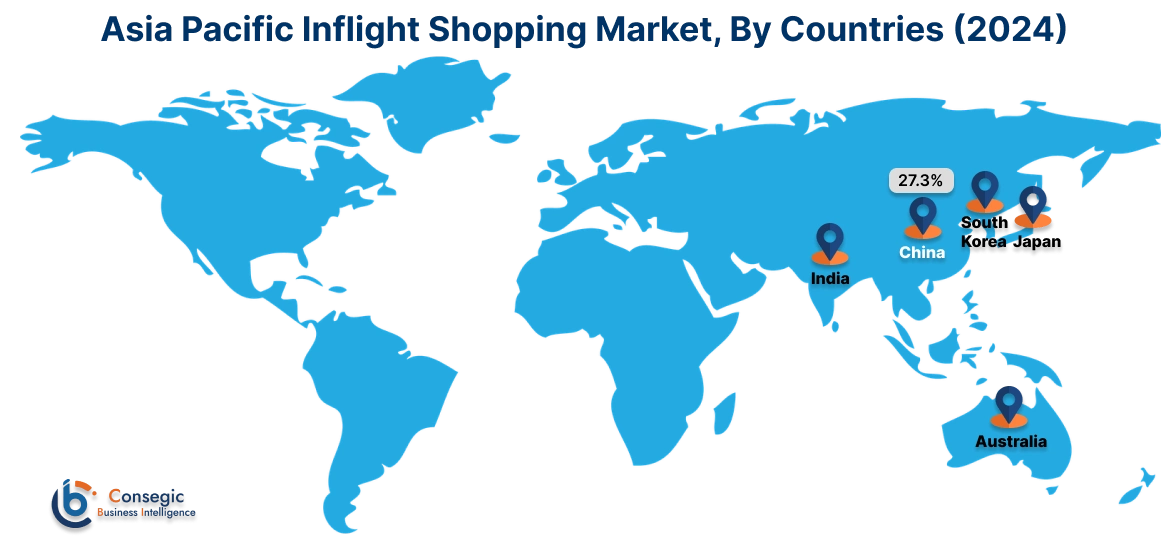
North American travelers are willing to splurge on duty-free goods, designer brands, and even tech gadgets during flights. Additionally, the region boasts a high volume of air travel, and the steady delivery of new aircraft to airlines will further expand the market for inflight online purchases. Furthermore, the increasing integration of advanced in-flight entertainment systems within North American airlines is a key driver of this expansion.
- For instance, in Jan 2025, United Airlines has announced a faster rollout of Starlink satellite internet, offering free access to all MileagePlus members. This high-speed connectivity will revolutionize inflight experiences, enabling passengers to stream, game, and even shop online during their flights.
As per the inflight shopping market analysis, European airlines often cater to a more affluent clientele, leading to a strong emphasis on luxury goods like spirits, perfumes, and high-end fashion. The integration of digital technologies, such as online pre-ordering and mobile payments in European airlines, is enhancing the shopping experience. Additionally, Latin America presents a significant growth opportunity due to increasing air travel and rising disposable incomes. Duty-free goods, particularly liquor and tobacco, remain popular due to lower prices compared to domestic markets. Furthermore, ME&A region is a major hub for luxury travel, with significant potential for high-end shopping. Unique regional products like perfumes, spices, and handicrafts are in high demand, which are contributing in boosting the market growth.
Top Key Players and Market Share Insights:
The market is highly competitive with major players providing products to the national and international markets. Key players are adopting several strategies in research and development (R&D), product innovation, and end-user launches to hold a strong position in the market. Key players in the inflight shopping industry include-
- Inmarsat plc (UK)
- Avolta AG (Switzerland)
- Lufthansa (Germany)
- AirAsia Group (Malaysia)
- The Emirates Group (UAE)
- Swiss International Air Lines AG (Switzerland)
- Thomas Cook Airlines Ltd. (UK)
- Singapore Airlines Limited (Singapore)
- EasyJet Airline Company Limited (UK)
- gategroup (Switzerland)
- Retail inMotion (Ireland)
Recent Industry Developments :
Partnerships & Collaborations:
- In June 2023, SkyLux Consultancy unveiled its "Inflight Shop" an innovative platform designed to be a one-stop shop for aircraft owners and flight attendants seeking to purchase a wide range of products for use on private jets. The Inflight Shop aims to streamline the procurement process, offering convenient access to essential items and enhancing the overall inflight experience for both passengers and crew.
Inflight Shopping Market Report Insights :
| Report Attributes | Report Details |
| Study Timeline | 2019-2032 |
| Market Size in 2032 | USD 7,546.66 Million |
| CAGR (2025-2032) | 7.9% |
| By Aircraft Type |
|
| By Carrier Type |
|
| By Shopping Type |
|
| By Region |
|
| Key Players |
|
| North America | U.S. Canada Mexico |
| Europe | U.K. Germany France Spain Italy Russia Benelux Rest of Europe |
| APAC | China South Korea Japan India Australia ASEAN Rest of Asia-Pacific |
| Middle East and Africa | GCC Turkey South Africa Rest of MEA |
| LATAM | Brazil Argentina Chile Rest of LATAM |
| Report Coverage |
|
Key Questions Answered in the Report
How big is the Inflight Shopping market? +
The Inflight Shopping Market Size is estimated to reach over USD 7,546.66 Million by 2032 from a value of USD 4,312.40 Million in 2024 and is projected to grow by USD 4,549.84 Million in 2025, growing at a CAGR of 7.9% from 2025 to 2032.
What specific segmentation details are covered in the Inflight Shopping report? +
The inflight shopping report includes specific segmentation details for aircraft type, carrier type, shopping type, and regions.
Which is the fastest segment anticipated to impact the market growth? +
In the Inflight Shopping market, the low-cost is the fastest-growing segment during the forecast period.
Who are the major players in the Inflight Shopping market? +
The key participants in the Inflight Shopping market are Inmarsat plc (UK), Avolta AG (Switzerland), Lufthansa (Germany), AirAsia Group (Malaysia), The Emirates Group (UAE), Swiss International Air Lines AG (Switzerland), Thomas Cook Airlines Ltd. (UK), Singapore Airlines Limited (Singapore), EasyJet Airline Company Limited (UK), gategroup (Switzerland), Retail inMotion (Ireland) and Others.
